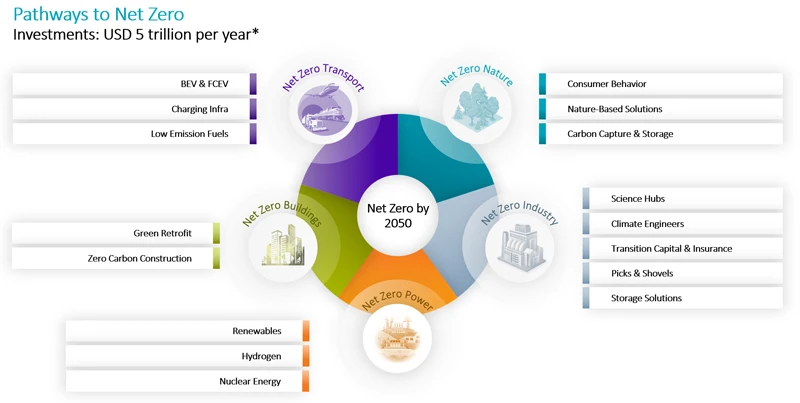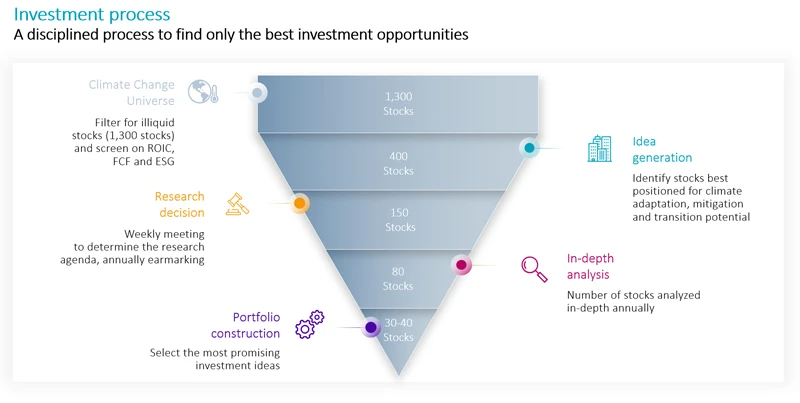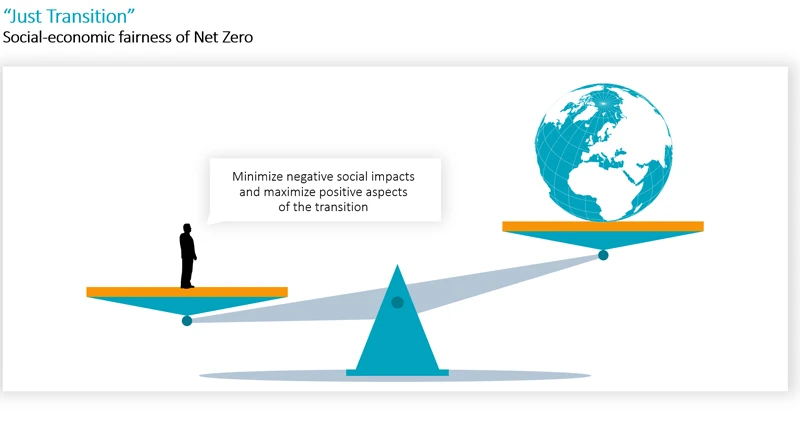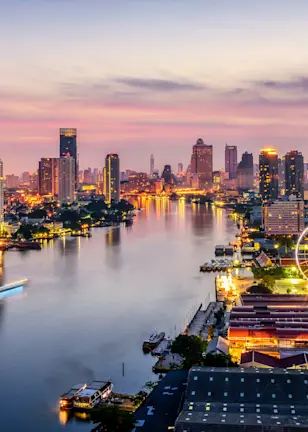Unlike many climate strategies that target green industries such as renewable energy that are already close to or are at net zero carbon emissions, the new strategy will specifically look for those that are transitioning. The criteria for inclusion is strict to avoid it morphing into “yet another environmental strategy”, says its portfolio manager, Chris Berkouwer.
Companies that have a clear decarbonization pathway to becoming net zero by 2050 will be eligible, along with those that can help others to achieve it, such as mining equipment suppliers, nature-based assets or transition capital providers. The strategy will also have a clear focus on the ‘just transition’, incorporating social factors such as the potential loss of jobs among higher emitters.
The high-conviction strategy follows a dedicated climate transition benchmark, the MSCI World Climate Change Index, rather than a standard index. This will make it easier to judge the success of the strategy, says Berkouwer, who also runs the Robeco Sustainable Global Stars Equities strategy.
The world must become carbon neutral by 2050 if the Paris Agreement temperature targets are to be met. This seeks to limit global warming to 2 degrees Celsius above pre-industrial levels by 2100, and more ideally to limit the rise to 1.5 degrees. Some 1.25 degrees of warming has already occurred, due mostly to billions of tons of greenhouse gas emissions since the industrial era began.
A unique tailwind
“We have a unique tailwind on the policy, technology and capital sides of decarbonization where all the planets are aligning and yet time is running out,” says Berkouwer. “So, we need to act now.”
“We need to invest in those companies actively offering solutions to climate change through decarbonization of one form or another. It’s not a case of targeting the companies that already have a low carbon footprint.”
“Instead, we’ll look for the companies leading the transition in the real economy, and also those whose businesses activities can help other companies to get there. For example, hydrogen producers are helping to reduce reliance on fossil fuels. You might say we’re also looking for the ‘picks and shovels’ companies – buying the builders as well as the building.”

The real economy’s five roads to net zero in nature, transport, buildings, power and industry.
Source: IEA; GS Sustain, McKinsey, BAML research
Narrowing the universe
Berkouwer says this means narrowing down a universe of about 1,300 stocks to just 30-40 members of the portfolio. Aside from standard ESG integration that can filter out the winners, the proprietary Robeco SDG framework will also be used.
“The problem that many of the climate funds out there have is that they’re focused on making sure the carbon footprint of the portfolio is really low, often by simply excluding the high emitters,” he says. “If you do that you miss out on those companies that might have a heavy footprint now but are on a strong transition pathway to decarbonize.”
“Something that we do differently, for example, is to go beyond the traditional climate focus in the clean tech space. The solutions to climate change are very broad based across all sectors, and targeting that is something you generally do not see. So, this is a product with its feet deeply rooted in the real economy.”

Portfolio construction – narrowing a universe of 1,300 stocks down to about 30-40.
Source: Robeco
The just transition
Following a ‘just transition’ means considering the social impacts of change, such as ensuring that coal miners can retrain to work in renewable energy.
“We should be conscious of the fact that decarbonization will not happen in an isolated fashion – it will affect the broader community,” Berkouwer says. “How do you make sure that your employees can adapt and be retrained if necessary during the transformation of the company? It’s not acceptable to just fire everybody.”
“Some businesses will be much more affected by this than others – those with one foot in the traditional old economy. They might have to radically alter their business model, so we should work to make sure that the negative social impact is minimized.”

A just transition needs to maintain fairness.
A bespoke benchmark
Another feature of the strategy is following the specially created MSCI World Climate Change Index. “We're one of the first asset managers actually using a dedicated climate benchmark as well, not just for assessing carbon footprint purposes, but also for performance measurement,” Berkouwer says. “We need to practice what we preach and be prepared to be judged on it.”
“It’s also important to distinguish the strategy from the traditional trend or thematic strategies that are inherently more growth oriented. This strategy needs a much more comprehensive approach in order to tackle the CO2 problem. That means broad diversification across all sectors.”
“So, it won’t have an outspoken growth or value tilt. What is important is that, just like the Sustainable Global Stars philosophy, it has a quality bias. Portfolio companies need to have a proven business model – there is little room for unicorns.”
Keep up with the latest sustainable insights
Join our newsletter to explore the trends shaping SI.
Getting a head start
The strategy will seek a head start by buying companies that have already made some headway in decarbonizing. “The starting point is a 30% lower carbon footprint than the market,” says Berkouwer. “Then we’ll seek decarbonization pathways of 7% a year to meet the Paris goals.
“This means there is some overlap with existing Robeco products – perhaps a 10-15% overlap with some of the SDG strategies that also seek a 7% decarbonization per year, for example – but overall this will be minimal.”
“Defining the decarbonization pathways has become much clearer since the net zero initiatives we launched a few years ago. This wasn’t the case when many climate funds started in the early 2010s, and most ended up becoming broad-based environmental strategies. It’s only recently that we have had a better view of the solutions, as science has become better able to identify the problem areas and specific solution pathways, which equips us better to play this via a dedicated climate strategy.”

Pathways to net zero in terms of the gigatons of CO2 equivalent that needs to be removed.
Source: IPCC, IEA, BAML research
It’s all about ‘net’
Investors should also be aware that net zero means exactly that; since some emissions simply cannot be avoided, they can be offset instead using nature-based or technology solutions such as carbon capture.
“Another feature will be investing in carbon removal solutions,” Berkouwer says. “The laws of physics basically prevent us from getting to net zero with all of these sectors by 2050 – it's impossible. We need to offset the emissions that will remain with carbon removal. That could be carbon capture and storage technology, but using nature based solutions as well.”
“One of the big holdings in the portfolio is a forestry company which is planting millions of trees,” Berkouwer says. “They have massive timberlands on which they generate carbon credits that can be sold. The big oil companies are never going to reach their net zero targets unless they also buy a lot of these carbon credits and ask these guys to plant massive amount of trees on their behalf.”
“After 30 years, they cut down the older trees and they sell it to the wood construction companies who use it for residential construction. It’s all part of the solution; this is the business model of the future, combining carbon offset with sustainable forestry.”
Investor demand
Demand for the strategy is set to be strong if the views expressed in the Robeco Global Climate Survey 2022 translates into real money being placed in solutions. In the survey published in March, 85% of the 300 investors who gave responses said climate change would be a central part of their investment policies over the next two years, while 75% have it taking center stage today.
Climate strategies of all flavors have become particularly important to insurance companies who face a double whammy from global warming – rising liabilities from weather-related damage claims as they must also decarbonize their assets to meet regulatory requirements.
“We are now so aware of the physical impacts of climate change – we feel nature speak to us,” says Lucian Peppelenbos, Climate Strategist at Robeco. “There is a clear shift to making a real world impact, with an increased realization that real assets are directly linked to real impacts, particularly when we talk about climate and biodiversity.”



















